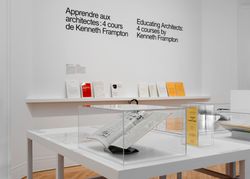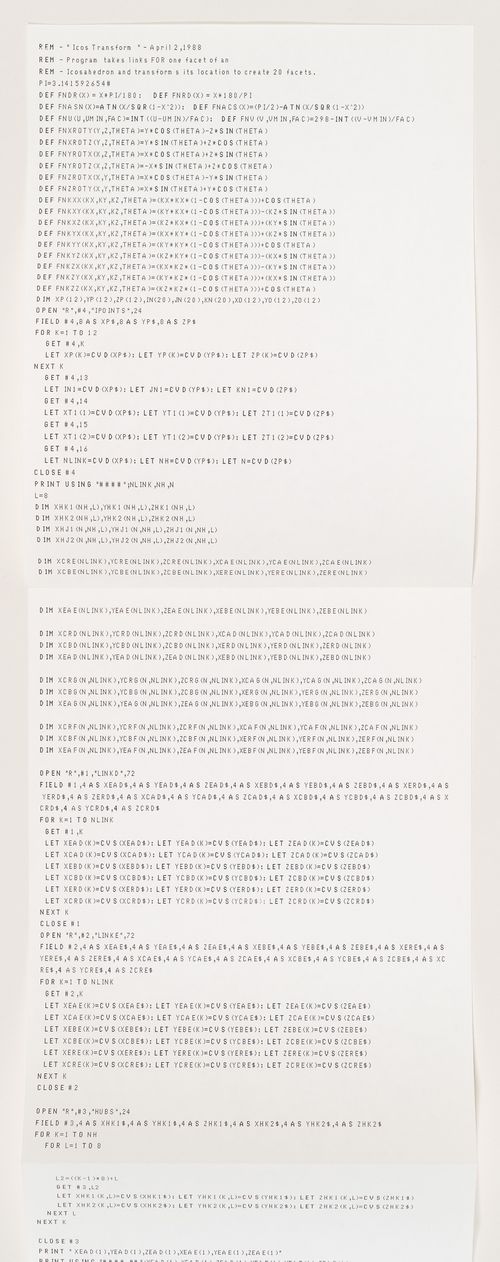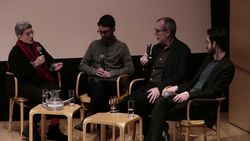Projet
Guardiola House
AP143.S4.D73
Description:
File documents the unexecuted project for Guardiola House, Cádiz, Spain. Material in this file was produced in 1988. File contains conceptual drawings, design development drawings, photographic material, presentation drawings, working drawings, models, and textual records. Drawings by Eisenman include conceptual sketches (DR1994:0147:001-004), and a drawing and final presentation drawing of the transformation process (DR1994:0147:279; DR1994:0147:635). Drawings by Eisenman's office include: samples for serigraphed drawings (DR1994:0147:644-669); drawings for house model construction (DR1994:0147:387-438); and presentation drawings in coloured film on KC5 (DR1994:0147:635-643). A schematic set shows an early scheme for the house: a site and situation plan, two longitudinal sections, floor and roof plans, transverse sections and a section showing construction materials (DR1994:0147:361-367). Four "record blueprint sets" of working drawings are dated between April and May 1988 (DR1994:0147:606-609). Documents include a list of security procedures for Eisenman's office, a schedule for Guardiola House, a report from Static engineering firm, Barcelona, a copy of the Aedes Gallery catalogue on Guardiola House, a filing index and list of the drawings, an address directory, a description of the project, correspondance, and a contract between the architect and client (DR1994:0147:1069-1071). Photographs and photocopies document an early working model of the house which no longer exists (photographs: DR1994:0147:1054-1056; photocopies: DR1994:0147:1056-1067). Miscellaneous drawings in this group include: an incomplete set of blueprints of Alvaro Siza's project for the same site (DR1994:0147:1073); a set of working drawings by Spanish architects for a project in Barcelona which Eisenman referred to when developing this project (DR1994:0147:1074); and Eisenman's designs for a lamp and carpet for Cleto Munari (not part of this project; DR1994:0147:894-1049). Conceptual drawings include plans, site plans, elevations, sections, and axonometrics - mostly black felt-tip pen and/or graphite on white or yellow tracing paper. Design development drawings include plans, site plans, elevations, sections, perspectives and axonometrics - some graphite on tracing vellum; sets - many blueline prints on wove paper; and reprographic copies - some photocopies on tracing vellum or wove paper. Presentation drawings include plans, elevations, and sections - all translucent adhesive coloured film on stats; reprographic copies - all stats; and screen prints on wove paper. Working drawings include plans, site plans, elevations, sections, and details - some pen and black ink on mylar; sets - many coloured pencil on blueline prints on wove paper; and reprographic copies - some photocopies on wove paper. Furniture drawings include plans and elevations for a lamp and carpets - many black felt-tip pen on yellow tracing paper; reprographic copies - mostly photocopies on wove paper; and a manuscript - one typescript on wove paper. Parts of models include - all grey paint on cardboard; photographs of a model; and reprographic copies - all photocopies of photographs of models. Textual records include project files, notes, correspondence, and project files - mostly typescripts on wove paper; sets include copies of drawings - many photocopies on wove paper; and reprographic copies - one photocopy on wove paper. Models include one grey paint on wood and cardboard model.
1988
Guardiola House
Actions:
AP143.S4.D73
Description:
File documents the unexecuted project for Guardiola House, Cádiz, Spain. Material in this file was produced in 1988. File contains conceptual drawings, design development drawings, photographic material, presentation drawings, working drawings, models, and textual records. Drawings by Eisenman include conceptual sketches (DR1994:0147:001-004), and a drawing and final presentation drawing of the transformation process (DR1994:0147:279; DR1994:0147:635). Drawings by Eisenman's office include: samples for serigraphed drawings (DR1994:0147:644-669); drawings for house model construction (DR1994:0147:387-438); and presentation drawings in coloured film on KC5 (DR1994:0147:635-643). A schematic set shows an early scheme for the house: a site and situation plan, two longitudinal sections, floor and roof plans, transverse sections and a section showing construction materials (DR1994:0147:361-367). Four "record blueprint sets" of working drawings are dated between April and May 1988 (DR1994:0147:606-609). Documents include a list of security procedures for Eisenman's office, a schedule for Guardiola House, a report from Static engineering firm, Barcelona, a copy of the Aedes Gallery catalogue on Guardiola House, a filing index and list of the drawings, an address directory, a description of the project, correspondance, and a contract between the architect and client (DR1994:0147:1069-1071). Photographs and photocopies document an early working model of the house which no longer exists (photographs: DR1994:0147:1054-1056; photocopies: DR1994:0147:1056-1067). Miscellaneous drawings in this group include: an incomplete set of blueprints of Alvaro Siza's project for the same site (DR1994:0147:1073); a set of working drawings by Spanish architects for a project in Barcelona which Eisenman referred to when developing this project (DR1994:0147:1074); and Eisenman's designs for a lamp and carpet for Cleto Munari (not part of this project; DR1994:0147:894-1049). Conceptual drawings include plans, site plans, elevations, sections, and axonometrics - mostly black felt-tip pen and/or graphite on white or yellow tracing paper. Design development drawings include plans, site plans, elevations, sections, perspectives and axonometrics - some graphite on tracing vellum; sets - many blueline prints on wove paper; and reprographic copies - some photocopies on tracing vellum or wove paper. Presentation drawings include plans, elevations, and sections - all translucent adhesive coloured film on stats; reprographic copies - all stats; and screen prints on wove paper. Working drawings include plans, site plans, elevations, sections, and details - some pen and black ink on mylar; sets - many coloured pencil on blueline prints on wove paper; and reprographic copies - some photocopies on wove paper. Furniture drawings include plans and elevations for a lamp and carpets - many black felt-tip pen on yellow tracing paper; reprographic copies - mostly photocopies on wove paper; and a manuscript - one typescript on wove paper. Parts of models include - all grey paint on cardboard; photographs of a model; and reprographic copies - all photocopies of photographs of models. Textual records include project files, notes, correspondence, and project files - mostly typescripts on wove paper; sets include copies of drawings - many photocopies on wove paper; and reprographic copies - one photocopy on wove paper. Models include one grey paint on wood and cardboard model.
File 73
1988
Lors de la réforme de l’enseignement dans les écoles d’architecture américaines durant les années 1970, Kenneth Frampton a joué un rôle de premier plan dans la transformation du programme de la Graduate School of Architecture Planning de Columbia University. Il a notamment créé et enseigné les trois cours de base du programme: le séminaire théorique «Comparative Critical(...)
Salle octogonale Mot(s)-clé(s):
Kenneth Frampton, Columbia, Princeton, teaching, GSAPP
31 mai 2017 au 24 septembre 2017
Apprendre aux architectes : quatre cours de Kenneth Frampton
Actions:
Description:
Lors de la réforme de l’enseignement dans les écoles d’architecture américaines durant les années 1970, Kenneth Frampton a joué un rôle de premier plan dans la transformation du programme de la Graduate School of Architecture Planning de Columbia University. Il a notamment créé et enseigné les trois cours de base du programme: le séminaire théorique «Comparative Critical(...)
Salle octogonale Mot(s)-clé(s):
Kenneth Frampton, Columbia, Princeton, teaching, GSAPP
Icos Transform
ARCH265794
Description:
"Program takes links FOR one facet of an Icosahedron and transforms its location to create 20 facets."
2 April 1988
Icos Transform
Actions:
ARCH265794
Description:
"Program takes links FOR one facet of an Icosahedron and transforms its location to create 20 facets."
None
1 février 2018
Matthieu Caron et Robert Burley : la découverte des villes du parc
Actions:
Description:
None
dessins
ARCH274771
Description:
Plan du système de protection des incendies et de la canalisation principale du bâtiment. Détails des prises d'eau et des valves des ailes D et C ainsi que des drains de la salle des transformateurs.
1928 - 1930
Plan du système de protection des incendies et de la canalisation principale du bâtiment
Actions:
ARCH274771
Description:
Plan du système de protection des incendies et de la canalisation principale du bâtiment. Détails des prises d'eau et des valves des ailes D et C ainsi que des drains de la salle des transformateurs.
dessins
1928 - 1930
dessins
ARCH275946
Description:
Détails de la salle de presse : béton pour les fondations de la presse, des planchers et du plafond. Détails de l'électricité : plateforme du panneau de contrôle, de la salle des transformateurs et des générateurs.
1935 - 1936
Détails de la salle de presse et de l'électricité
Actions:
ARCH275946
Description:
Détails de la salle de presse : béton pour les fondations de la presse, des planchers et du plafond. Détails de l'électricité : plateforme du panneau de contrôle, de la salle des transformateurs et des générateurs.
dessins
1935 - 1936
recherche
Thème : Le phénomène baroque au-delà de Rome : Mark Dorrian, Département d’architecture, Université d’Édimbourg, Édimbourg, Royaume-Uni Sujet : Baroque Deformation Martina Frank, Département d’histoire, Université d’Udine, Udine, Italie Sujet : Luca Danesi et le baroque vénitien Indra McEwen, École nationale de théâtre du Canada, Montréal, Canada Sujet : The State of(...)
janvier 2000 au août 2000
Chercheurs en résidence 1999–2000
Actions:
Description:
Thème : Le phénomène baroque au-delà de Rome : Mark Dorrian, Département d’architecture, Université d’Édimbourg, Édimbourg, Royaume-Uni Sujet : Baroque Deformation Martina Frank, Département d’histoire, Université d’Udine, Udine, Italie Sujet : Luca Danesi et le baroque vénitien Indra McEwen, École nationale de théâtre du Canada, Montréal, Canada Sujet : The State of(...)
recherche
janvier 2000 au
août 2000
dessins
ARCH276034
Description:
Plans et détails des toilettes publiques, des lucarnes, de la cheminée de la salle des juges, du plafond du hall principal des voûtes, de la salle des transformateurs et de la finition du sous-sol.
1939
Plans et détails des toilettes publiques, des lucarnes
Actions:
ARCH276034
Description:
Plans et détails des toilettes publiques, des lucarnes, de la cheminée de la salle des juges, du plafond du hall principal des voûtes, de la salle des transformateurs et de la finition du sous-sol.
dessins
1939
dessins
ARCH275659
Description:
Détails des escaliers, des ascenseurs, de la charpente, de la chambre de presse, des transformateurs, du terrain, de la plateforme du panneau de contrôle et des étages. Feuilles de calcul du chauffage et dessin d'une presse de Chicago.
1944 - 1948
Détails d'exécution
Actions:
ARCH275659
Description:
Détails des escaliers, des ascenseurs, de la charpente, de la chambre de presse, des transformateurs, du terrain, de la plateforme du panneau de contrôle et des étages. Feuilles de calcul du chauffage et dessin d'une presse de Chicago.
dessins
1944 - 1948
dessins
Quantité:
22 File
ARCH38600
Description:
floor plans, property plan, partial floor plans, elevation of press machine, door openings, transformer room, water mains, canopy
Floor plans, property plan, partial floor plans, elevation of press machine, door openings
Actions:
ARCH38600
Description:
floor plans, property plan, partial floor plans, elevation of press machine, door openings, transformer room, water mains, canopy
dessins
Quantité:
22 File


